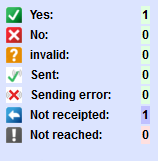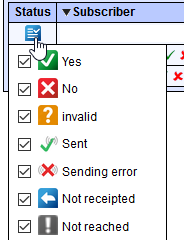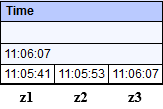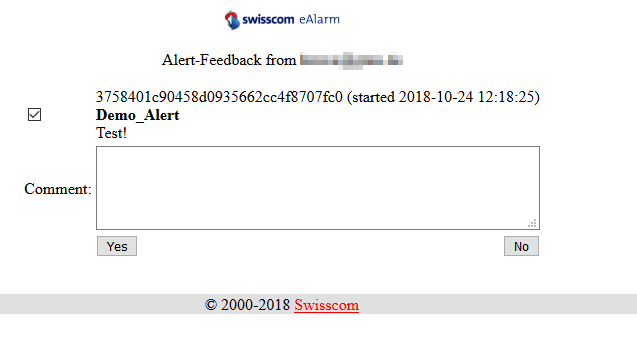Running alerts
Alert feedback
Once the alert has been triggered, the “Alert feedback” screen appears. Here you get a real-time overview of the alert history and feedback from your alerted subscribers.

Press the “Stop cascade”  button to end the cascade and then close the alert, or, if no cascade is active, you can also end the alert directly by pressing the “Close alert”
button to end the cascade and then close the alert, or, if no cascade is active, you can also end the alert directly by pressing the “Close alert”

Alert overview
You will find a summary of the alert in the upper part of the feedback menu.

-
Trigger time and duration of the alert, alert name, description and text
-
Status bar of acknowledgements
-
Traffic light: Provides information on whether the predefined threshold for successful alerts has been reached. Yellow means that a predefined number of subscribers has already positively acknowledged the alert. Green means that the required number of positive replies, as predefined in the registry, has been reached and you can stop the alert.
-
Overview of feedback

- Yes: Positive Feedback
- No: Negative Feedback
- Invalid: Reply with invalid syntax (see the “Acknowledgement” section for more information)
- Sent
- Sending error
- Not receipted: No feedback yet
- Not reached
Overview of subscribers
The bottom part of the feedback menu lists the subscribers to be alerted and their corresponding status and alert media.

The  button can be used to filter the
list by subscriber status, to show only positive feedback, for example.
button can be used to filter the
list by subscriber status, to show only positive feedback, for example.

The Time column provides information about the alerting process used for the individual types of media:

- z1: Time triggered
- z2:
- for SMS = receipt of the delivery confirmation
- for pagers/e-mail = receipt of the confirmation of transmission to Swissphone/mail server
- for calls = start of connection or time of error
- for faxes = sent to the fax server
- z3:
- for SMS/e-mail = receipt of acknowledgement
- for calls = end of connection
- for faxes = outgoing fax report from the fax server
Select the “Group view” option to display the alerted units.
Acknowledgement
Call
If the alert is conveyed by phone, a voice will read the alert text and provide instructions on how to acknowledge it correctly. This is done by keypad.
If the alert is sent by e-mail, you can either send an e-mail reply or follow the link in the e-mail and acknowledge it there.
To do so, follow the instructions provided in the e-mail alert.

SMS
SMS replies must follow a specific syntax. They must begin with one of the following keywords:
“Yes” or “No”, “OK” or “NOK”, “Ja” or “Nein”, “Oui” or “Non”, “Si” or “No”.
Additional text must be separated from the keyword by a space!
Examples of valid replies:
| Positive | Negative |
|---|---|
| Yes I’ll be there in 20 minutes | No I’m unable to come |
| Yes I’m coming | No not possible |
| OK | NOK |
| OK I’ll be there | NOK I’m unable to come |

Examples of invalid replies:
- That’s OK I’ll be there (reply does not begin with keyword)
- Yes, in 15 min. (keyword separated by comma)
If eAlarm emergency cannot evaluate the replies due to incorrect syntax, the alert recipient is assigned the status “Invalid” and the entire SMS reply is shown in the results column.

The triggering party / dispatcher can manually set the “Result” to “Yes” or “No” based on the text by selecting the green tick
 or the red cross
or the red cross  .
If the recipient manually sets the subscriber to “Yes”, for example, the subscriber is displayed in eAlarm emergency as follows.
.
If the recipient manually sets the subscriber to “Yes”, for example, the subscriber is displayed in eAlarm emergency as follows.
 The original text in the result is overwritten with the information on the manual status change.
The original text in the result is overwritten with the information on the manual status change.